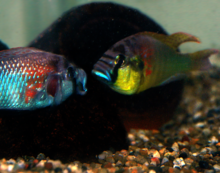Above is an excellent, and sometimes heated, debate between Dr. Jack Horner- who posits that Torosaurus is the adult morph of Triceratops- and Dr. Nick Longrich- who maintains they are separate species. Both parties bring some very pertinent and compelling arguments to the table- although Horner seems to have the edge in terms of humour and comfortability in his presentation.
Anyone at all interested in dinosaur studies is probably well versed on the compelling Triceratops/Torosaurus debate as it has morphed (hahaha) into one of the more fascinating discourses in dinosaur paleontology. And chances are that if you are reading this blog you are that type of person- if not watch the debate above and the video at the end of this post to catch up. So what this post is about is not a summary of the debate- I am too lazy and have a little too much carpal tunnel syndrome to do that- but I want to describe my take on the issue and how both scientists may actually be right on certain levels.
It is one of the self-evident traits of humans that when we subscribe to an idea- especially if we ourselves take part in the genesis of that idea- that we, almost without exception, become beholden to that idea. And even well trained scientists, armed with sceptical/analytical minds, are not exempt from the potential pitfalls of the "inception" phenomena- and will often hold onto an outdated/disproven theory to the detriment of their own careers.
And so what we have in the above video is a clear line drawn in the sand, succinctly summed up by Horner when he states towards the end of the debate "One of us is right and one of us is wrong". I, as I alluded to earlier, take exception to this statement and believe a third theory accounts for the data as it now stands very comfortably. But to do that we must first talk about fish, specifically cichlids. While cichlids are not what immediately comes to mind when discussing the ontogenetic changes of ceratopsids I do believe that one species provides a useful model for what might just be going on with good ol' three horned face.
Rapid behavioral and genomic responses to social opportunity in cichlid fish Astatotilapia (Haplochromis) burtoni. In this paper a suite of hormonal/genetic changes occur in the male cichlid fish concurrent with achieving/usurping social dominance over other males. Color change occurs on the order of minutes while increased gonad production on the order of 1 week.
"These results show that the rapid behavioral responses to social opportunity were matched by a rapid genomic response in the brain," author Fernald says. "We didn't expect to get changes in gene expression in the brain so early in the process, just 20 minutes after the male has seen the prospect for social change."These results suggest that subordinate males are always looking for opportunities to change, Burmeister adds. "They must constantly be ready, because they make the shift in no time," she says. "They keep track of who's who and who's the biggest so they can take the opportunity to reproduce. An animal that goes through that kind of transition has to recall how he relates to other males, and also has to be aware that he can change. This raises a bigger question about sophisticated social awareness in fish. After all, socialization requires more brainpower, and all vertebrates—fish, amphibians, birds, humans—use a variety of cues in the environment."
All right so probably some of you are seeing where I am going with this- if a cichlid fish can rapidly change both its appearance/behavior/reproductive capacity with changing social status- then could Triceratops males have morphed into Torosaurus upon achieving dominance?
 |
| Astatotilapia burtoni males dueling. wiki |
And if we look at the data/arguments that both Horner/Longrich site- this scenario of morphological change in male Triceratops concurrent with social change nestles quite nicely.
1) Torosaurus is rare. Both Horner and Longrich agree on this point. And this pattern should be expected if Torosaurus represents the rare dominant male in the population. The vast majority of males, especially in harem forming animals, do not achieve dominance/reproductive success. When they do their time at the top is very limited. In this scenario the vast majority of Triceratops will never achieve dominance and therefore never achieve the Torosaurus morph. As noted by Longrich in the above video we do see very large/old Triceratops which should be expected in this scenario.
2) Lack of transitional forms. If Torosaurus indeed represents dominant male Triceratops then we should expect this morph to be necessarily short term based on what is observed for extant combative male animals. The brevity of male dominance implies the morphological change from Triceratops to Torosaurus morph was rather quick. Not suggesting the change occurred at the same speed as the cichlid changes, but more probably on the order of months rather than years. And this small window of time for transition means that the chances of this transitional state being preserved is rather rare and may never he documented.
3) Young Torosaurus. As noted by Horner we do not see hatchling/young/immature Torosaurus. In my scenario this pattern should be expected because the dominance cues would not kick in until the Triceratops was at least large enough to hold its own against other bulls. Note that this scenario does not preclude still growing/unfused Triceratops to achieve dominance and therefore become Torosaurus morph before full adulthood. Longrich cites examples of Torosaurus with unfused bones/smaller size. In certain circumstances of disease/predation/injury to the dominant bulls even immature males can achieve dominance before attaining full maturity.
4) Ceratopsids, especially Triceratops, do display some characteristics of harem forming animals. Both Horner/Longrich allude to potential dimorphism in ceratopsids which should be expected. The horns, frill, and head gear are the most obvious signals that combative/harem forming social behavior may have been the norm. Keep in mind that ceratopsids were combatting each other as well as multitonne tyrannosaurs. The large billboard of a frill of the Torosaurus morph may have been a warning to other ceratopsids as well as menacing theropods- "Hey you wanna get to those females you gotta get through me first."
Potential problems with my theory. Spatial disparity between Torosaurus and Triceratops. As Longrich points out in the video there does appear to be geographic variation between where Torosaurus is found and where Triceratops is found. He concedes there could be certain taphonomic biases at play as well. Perhaps future work will clear this up. Are fish really good analogues for ornithischian dinosaurs? Some may argue that fish are more basic and less advanced than dinos. I disagree, cichlids especially show complex behavioral processes and group dynamics. Anyone who has kept cichlids as pets would agree. While a change in color is less dramatic than a whole scale reworking of the skull it should also be noted that very small switches of gene expression can result in large scale morphological change.
Although my hypothesis presented here may currently be "untestable" and therefore outside the realm of science I do think it brings a new dimension to the "Toroceratops" debate.
Cheers!!!
Pertinencia
Shape Shifting Dinosaurs. Ted Talk Feb 9, 2012
Article Source: Rapid Behavioral and Genomic Responses to Social Opportunity(2005) Rapid Behavioral and Genomic Responses to Social Opportunity. PLoS Biol 3(11): e363.doi:10.1371/journal.pbio.0030363
Support me on Patreon.
Like antediluvian salad on facebook.
Watch me on Deviantart @NashD1.Subscribe to my youtube channel Duane Nash.
My other blog southlandbeaver.blogspot.


No comments:
Post a Comment